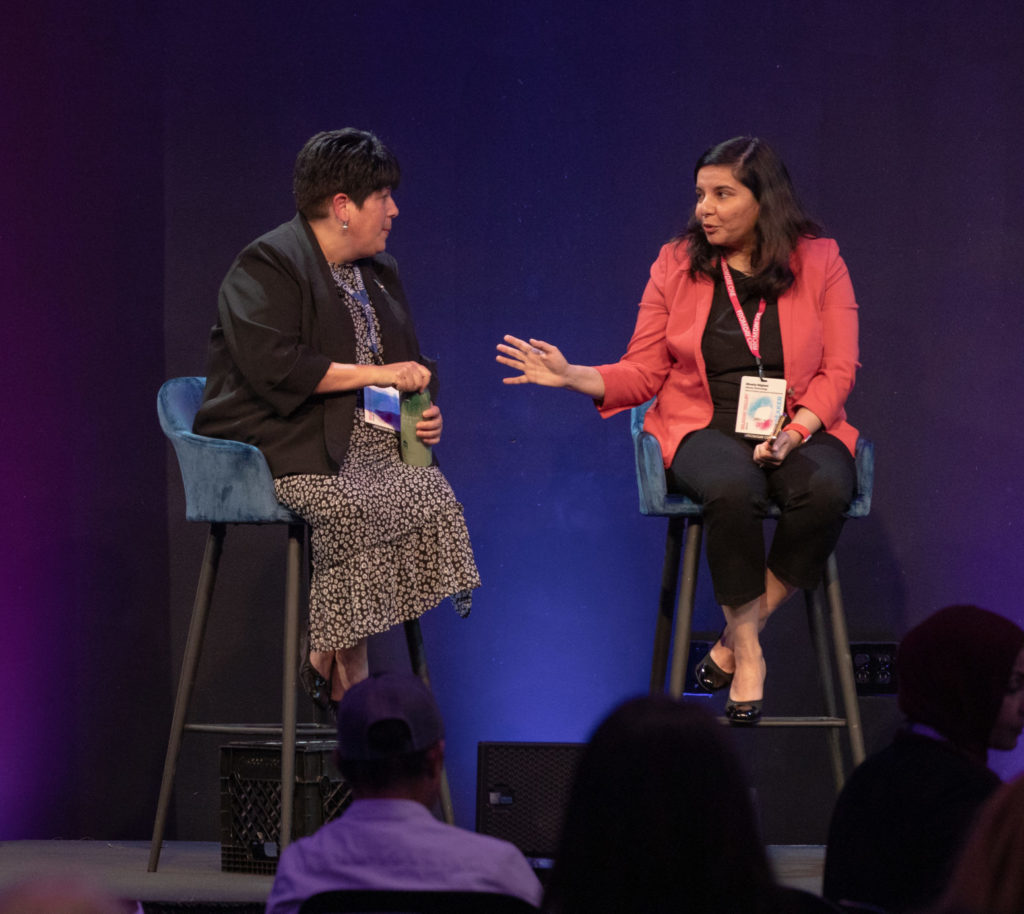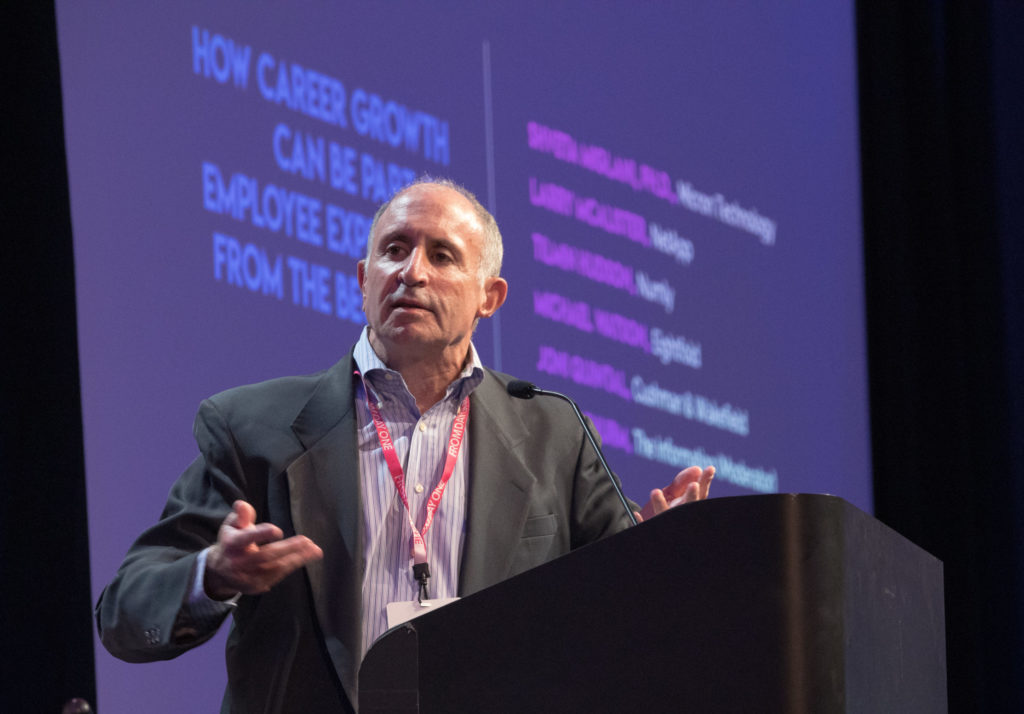Boosting Retention and Productivity Through Workforce Agility
Today’s talent has a lot of choices. Which means companies must build adaptable and agile workforces to drive both retention and productivity. This approach goes beyond standard policies, recognizing the distinct career aspirations and evolving expectations of workers across a diverse range of roles.In a recent panel discussion at From Day One’s Denver’s conference, moderated by Erica Breunlin of the Colorado Sun, industry leaders shared insights into strategies that empower employees, close skills gaps, and foster flexibility. Their insights highlight a shift toward greater workforce transparency, mentorship, and the restructuring of traditional work expectations.In a recent survey of employees at Randstad RiseSmart, they asked: Is it easier for you to find a job within the company or outside the company? Forty-five percent said it was easier to find a job outside the company.“We then asked corporate recruiters the same question,” said panelist Chris Harrington, SVP, sales and customer success at Randstad RiseSmart. “55% of them said from outside the company, like they know the secret’s out.”For many, being a gig or contract worker has become easier and more attractive, he says. And it’s not just IT workers or other similar industries. A Fortune 100 CEO recently told Harrington that when trying to hire a CIO, the candidate asked if they could be a contractor rather than an employee.“Employees and the employers together are realizing that there’s a huge gap,” Harrington said. “Employees have a lot of choices, candidly, and so the choice has really exploded.”When there’s a lot of choice, employees will go where they get the most flexibility. Some will go towards remote work, meaning those who mandate back-to-office days could be shrinking their talent pool. Others will be attracted to career potential within the company.Employers should be very thoughtful about how they approach these types of decisions. Ultimately, it comes down to transparency, he said.Executive panelists spoke about "Boosting Retention and Productivity Through Workforce Agility" at From Day One's Denver conference“I don’t think as employers, we're doing a great job being transparent with our employees around what their own opportunities are, let alone how we go out to the external market and start to market,” Harrington said. “There’s an entire generation of workers that are coming into the workforce looking for a diverse set of experiences. We can do that, and I think we need to get a little bit smarter around it and figure out how to better market it to the employee base.Closing the GapsThere are three distinct gaps with this workforce–a skills gap, an expectations gap, and a visibility gap, says panelist Erick Allen, principal at Cornerstone.“There’s data that says one in three employees don’t feel they have the skills to do the job that they’re currently employed in. Just think about that,” Allen said. There’s a huge opportunity for organizations to close the skills gap by paying attention to those, then offer learning opportunities and mentorship.Second is the expectations gap. In a Cornerstone survey, 49% of employees felt that their employers were doing a poor job at either upskilling or reskilling. “Yet 89% of executives felt they were doing a great job,” he added. That’s a huge gap between employees and leaders that needs to be closed by offering opportunities for upskilling.Third, there is a visibility gap. The hiring process typically involves a narrow set of skills in order to land the job. But what after? What other skills do they have and how can the company best utilize them?“We have done ourselves in disservice with applicant tracking systems in relation to skills visibility,” Allen said. “Once you get someone in, allow them to open up, and you will find out they have skills and abilities and things that they can do far outside of what they did.”Allen says that the Great Resignation of 2023, when 27% of the workforce voluntarily shifted jobs, hasn’t slowed down. Retention relies on closing major gaps and giving workers opportunities and flexibility.MentorshipRetention becomes significantly more challenging in large organizations, where a lack of personalization and difficulty scaling effectively can disengage employees. People don’t want to feel like just another face in the crowd.“Every employee is very unique and individual in the path that they want to pursue,” said panelist Elizabeth Bruns, director of business HR and global business group HR lead of Avanade. “Careers are no longer linear, so the career journey is going to be very much driven by that particular employee.”Not only that, but rapidly evolving technology means careers can change quickly, and companies should offer ways for them to gain skills. At Avanade, they’ve offered a Microsoft certification program that is constantly evolving with new technology. Plus, they developed an AI school so employees could learn more.Perhaps the biggest impact they’ve seen, though, is from a more one-on-one approach: career advisors. “The idea of a career advisor is they’re like your guiding light for your career journey,” she said. A project manager is the day-to-day work focus, but a career advisor is like a mentor for your career goals.“They can help aggregate performance feedback that you may have received, provide you with that developmental feedback, help you identify the specific paths that you might want to pursue from a development learning perspective, or just be a separate party that the person can talk to,” Bruns said.The personalization piece helps drive it home. Because in an organization with thousands, employees are getting the specific direction they need to have confidence in their current role and possible roles to come. Flexibility for the FrontlineWorkers want flexibility, but how does a company accomplish that for the non-remote worker? According to panelist Kristen Baller, head of talent acquisition at DISH Network, more than 60% of the workforce is blue collar, performing jobs that involve physical labor.“I would encourage us to really start to think about how we are talking to our leaders, to think not just about remote work, but flexibility,” she said. “How are we starting to think about the hours? Are we able to start to create shifts that align more with the school schedule, or start to thin through four day four day work weeks?”It becomes more complicated when you’re talking about large organizations with lots of people and factors to consider. As with any job, no matter whether they’re remote or frontline, keeping track of skills is paramount. With the right systems in place, a company can offer upskilling opportunities and ultimately better retain workers who feel valued.“As leaders, we’re responsible for not only keeping track of them, but giving the feedback and helping them understand what skills they’re doing to accomplish their jobs,” she said.Building an agile workforce is a multifaceted process that requires transparency, gap-bridging, personalized mentorship, and flexible thinking across all job types. By tackling these areas, organizations can foster a culture that values both individual career goals and collective success. Adapting to the demands of today’s workforce is essential for driving retention and boosting productivity.Carrie Snider is a Phoenix-based journalist and marketing copywriter.






